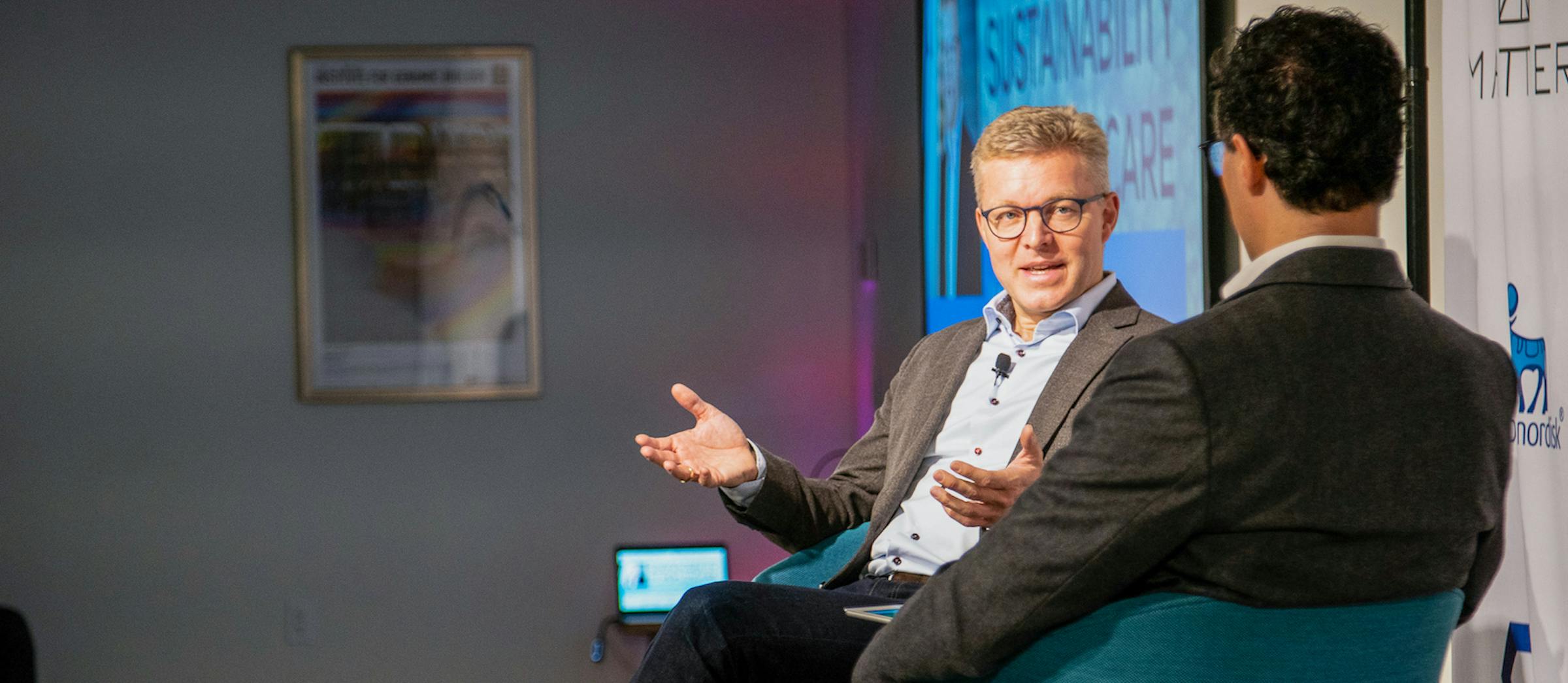The business case for sustainability in healthcare
A conversation with Novo Nordisk’s senior vice president for device R&D, Kenneth Strømdahl
In business today, “sustainability” is becoming somewhat of a buzzword.
But the growing demand from consumers has forced nearly every industry to think about sustainability as more than just a marketing or PR exercise. In order to stay relevant, companies must think strategically about how to reduce their environmental impact throughout all aspects of their business. For companies that invest the time and money in these solutions early, the benefits can far outweigh any upfront costs — and help industries at the forefront of environmental impact, like healthcare, change for good.
At Novo Nordisk, building a more sustainable business has been a priority for 20 years. But in 2018, leaders agreed that they could think even bigger than wind farms and carbon offsets.
The Circular for Zero initiative aims to reshape Novo Nordisk business practices for circularity: an environmental concept based on replacing the most common ‘take-make-waste’ model of product development with products that can be collected and reused. A truly circular economy would eliminate waste altogether by designing it out of the system.
One of the main focus areas of the Circular for Zero initiative is to develop more sustainable insulin injector pens. Each year, Novo Nordisk builds and distributes half a billion injector pens worldwide — many of which end up in landfills and take about 100 years to decompose. To address this problem, Novo Nordisk teamed up with MATTER and Green Innovation Group to host the 2019-20 Novo Nordisk Innovation Challenge: A global search for solutions to help Novo Nordisk improve the recyclability and circularity of these pens.
Kenneth Strømdahl, senior vice president for device R&D, is one of the leaders behind the Circular for Zero initiative and the Novo Nordisk Innovation Challenge. He recently joined us at MATTER to share more about how Novo Nordisk thinks about sustainability, circularity and recyclability, and what they’re doing to make their goals a reality.
Here’s a roundup of what we discussed at the event.
How Novo Nordisk defines sustainability
“From a Novo Nordisk point of view, sustainability is very much about the way that we act. It is about ensuring that the materials that we consume don’t compromise future generations of access to all the materials that we use today.”
The long term costs of not addressing sustainability
“This is very much about the future. It’s about reputation and our response to a growing demand — from both our patients and our payers. We strongly believe that in the future, unless we behave in an environmentally friendly way, we might not be able to sell our products in markets across the globe.”
“We could decide that this is a problem for the future to save money in the short term — but we would lose on the business side in the long term. If we spend the money right now, we can stay in the game and also pave the way for others. We are a global company and we have a huge footprint across the globe. If we are to deliver this company to our next generation, we can’t just pass it on, knowing that what we produce today will still be in the landfill 40 years from now.”
“This is very much about the future. It’s about reputation and our response to a growing demand — from both our patients and our payers.”
Deciding to commit to Circular for Zero
“We have had an environmental strategy for many, many years. Last year, leadership initiated a discussion asking, ‘Is this strategy up to date? Does it reflect the challenges that we have ahead of us?’
“I think 10 years back and we were very focused on trying to reduce CO2 emissions and we made contracts across the globe that helped offset our carbon footprint. But this is what lots of people today consider as a rather low hanging fruit. What about all the transportation of our goods across the globe? What about all the raw materials that we use, all the products that we produce? So in 2018, we started to initiate the next version of our environmental strategy and we put together some targets for where we would like to be in 2030.”
Target set. What does the road to 2030 look like?
“It’s somewhat of an undertaking to reach our goals for 2030, even though some people would argue that 10 years is a long time. But in a heavily regulated industry, it’s slightly more difficult to just change from one day to another.
“In the case of Novo Nordisk, the design of our injector pens are not something which we can just change tomorrow. Ideally, we could make a snap decision and just start making them out of bamboo or another bio-based material. But our priority is safety first. And we don’t have all the answers today. That’s one of the reasons why we’re here [at MATTER].”
Sustainability at Novo Nordisk: More than just injection pens
“We know, of course, the final target: zero. But again, how do we measure that? We are working together with institutions like the Ellen MacArthur Foundation to answer the hard questions: What is zero? How do we define sustainability? What is 100% sustainable? What is renewable?
“When you recycle a product, when you make your calculations, then also include all your sub-suppliers and their sub-suppliers and the energy consumed to produce that machinery, et cetera…How do we make all these calculations?
“And our products don’t just include pen injectors — it goes all the way through the value chain. What are the chemicals used? How much water do we need? What are the processes? How can we optimize to reuse water consumption? How can we reprocess and reuse water in our systems or ethanol and whatnot? This spring, we started implementing these considerations with design guidelines. It goes through lots of processes that we have in the company. It’s the start of our movement to get everyone in the company on the right mindset.”
“We know, of course, the final target: zero. But again, how do we measure that?”
Ensuring company adoption
“Introducing Circular for Zero guidelines and documentation was important, but implementation and execution are vital. To avoid poor execution, we’ve been hosting what we call sustainability schools and training every employee the organization about these principles.
“We’re hoping these will help teams understand what it is that we mean when we at the corporate level share ambitions for the future, and then drill that down: What does that mean for that individual’s part of the organization?
“And we are also very focused on the culture needed in the company to fully embrace a sustainability mindset. How do we talk about sustainability? How do we train people in the company? How do we introduce the future mindset that they’d be like in conversation, once you start designing new products for the future?”
Reducing environmental impact without increasing the user burden is key
“I strongly believe that we can’t add any further burden to the patient.
“Whatever changes we make to our products, we know we should never, ever add to the daily burden of managing a chronic disease. Putting the patient in the center of all of what we do, if we have to design solutions, which makes it at least as easy for them or even easier than, you know, managing the disease today. If they need to simply hand back these pens for reuse instead of throwing them away, that’s an easy choice.”
“Whatever changes we make to our products, we know we should never, ever add to the daily burden of managing a chronic disease.”
The case for collaboration
“Instead of trying to solve this massive problem on our own in our own offices and labs for, let’s say, the next 10 years, why not boost those efforts and reach out to the greater society? I think we have a movement right now where lots of people and universities are focusing much more on a more sustainable future.
“In the past, we just did everything in house. Right now we’re moving into new therapy areas in the company — and we need many more concepts than we’ve had in the past. We could take yet another 10 or 15 years to build up this new therapy area. Or we could try to tap into the broader environment of biotech companies and startup companies.
“This is about finding the ideal combination of our legacy and expertise with the new and out of the box solutions of others.”
The semifinalists for the 2019-20 Novo Nordisk Innovation Challenge have been chosen. Finalists will be announced following a private pitch event on Tuesday, January 14.



